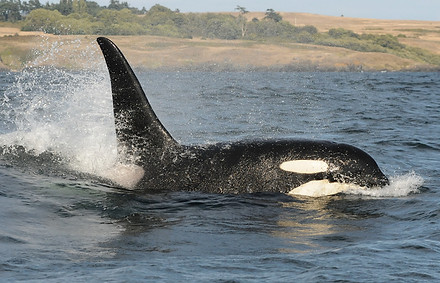
L92 spyhop - Photo by Dave Ellifrit, Center for Whale Research

L92 - Photo by Dave Ellifrit, Center for Whale Research
L92 1995-2018
With the loss of L92, the total number of Southern Resident killer whales is now 75 whales.
Press Release – June 15, 2018
L92 - Missing Southern Resident killer whale is presumed dead
On Monday, June 11, more than 50 Southern Resident killer whales returned to inland waters, including J pod, L87, and most but not all of L pod. It has been nearly 2 months since J pod whales and L87 have been seen in local waters, an unusually long break but not unexpected based on trends in the past decade. In recent years, encounter data and sighting data compiled by the Center for Research show that the Southern Residents have been spending fewer days in inland waters in the April-May time frame. This trend parallels a decline in the abundance of the Fraser River spring Chinook salmon runs. Based on data from the Albion Test Chinook Test Fishery on the Fraser River, the number of Chinook salmon returning to the Fraser River has been unusually low so far in 2018.
Research has shown that Fraser River Chinook salmon comprise a significant portion of their diet when these whales are foraging in their “core summer habitat” or in the Strait of Juan de Fuca south of Vancouver Island. In one study, research conducted during the months of May through September, 2004-2008, revealed that 80-90% of the Chinook salmon consumed by Southern Resident killer whales near the San Juan Islands and off the southern end of Vancouver Island originated from the Fraser River, with only 6‑14% originating from Puget Sound rivers (Reference 1). Research documented in a more recent publication also led to similar conclusions (Reference 2). It should be noted that of the wild Chinook salmon populations associated with Puget Sound rivers, 16 are classified as extinct and the remaining 22 populations are listed as threatened.

Current Southern Resident population census:
J pod: All of the J pod whales and L87 were confirmed to be present by CWR staff members. At this time, there are 23 whales in J pod.
L pod: Both L25, the oldest female in all three pods, and L41, the oldest male in all three pods, were confirmed to be present by CWR staff members. Genetic testing has revealed that L41 is the father of at least 20 of the Southern Resident killer whales (Reference 3).
However, L92 was not present. L92 was last sighted by CWR staff in November of 2017, but conspicuously absent from several coastal sighting reports from colleagues and the public earlier in 2018.
L92 is missing and presumed dead. L92, an adult male, was a member of the L26 matriline. With his death, the only surviving member of the L26 matriline is his aunt, L90.
The L54s, L84, and L88 have not yet returned to inland waters in 2018.
L pod currently has 34 members, down from nearly 60 members in the early 1990’s.
K pod: All of K pod was seen by CWR staff in March of 2018. K pod currently has 18 members.
With the loss of L92, the total number of Southern Resident killer whales is now 75 whales.

L92 - Photo by Dave Ellifrit, Center for Whale Research
References
(1) M. Bradley Hanson, Robin W. Baird, John K. B. Ford, Jennifer Hempelmann-Halos, Donald M. Van Doornik, John R. Candy Candice K. Emmons, Gregory S. Schorr, Brian Gisborne, Katherine L. Ayres, Samuel K. Wasser, Kenneth C. Balcomb, Kelley Balcomb-Bartok, John G. Sneva, Michael J. Ford. 2010. Species and stock identification of prey consumed by endangered southern resident killer whales in their summer range. Endang. Species Res. 11: 69–82
(2) Ford, M. J., Hempelmann J., Hanson, M. B., Ayres, K. L., Baird, R. W., Emmons, C. K., et al. (2016) Estimation of a Killer Whale (Orcinus orca) Population’s Diet Using Sequencing Analysis of DNA from Feces. PLoS ONE 11(1): e0144956. doi:10.1371/journal.pone.0144956
(3) J. Ford, M & Parsons, K & J. Ward, E & Hempelmann, Jennifer & Emmons, Candice & Hanson, M & C. Balcomb, K & K. Park, L. (2018). Inbreeding in an endangered killer whale population. Animal Conservation. 10.1111/acv.12413.


